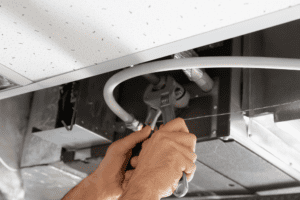 Regular air duct cleaning is an important step for maintaining any commercial building. Dirty air ducts impede the efficiency of your HVAC system, increase your utility costs, reduce indoor air quality, and affect the respiratory health of individuals who spend a lot of time in your building. For all these reasons, business owners and building managers need to keep a close eye on their ducts and keep up with a routine of having the ducts cleaned entirely every few years. Finding the right HVAC contractors for this job is also important. HVAC companies use a range of unique air duct cleaning tools to clean your ducts deeply and thoroughly—something that’s difficult to accomplish without the right equipment, skills, or knowledge.
Regular air duct cleaning is an important step for maintaining any commercial building. Dirty air ducts impede the efficiency of your HVAC system, increase your utility costs, reduce indoor air quality, and affect the respiratory health of individuals who spend a lot of time in your building. For all these reasons, business owners and building managers need to keep a close eye on their ducts and keep up with a routine of having the ducts cleaned entirely every few years. Finding the right HVAC contractors for this job is also important. HVAC companies use a range of unique air duct cleaning tools to clean your ducts deeply and thoroughly—something that’s difficult to accomplish without the right equipment, skills, or knowledge.
The Air Duct Cleaning Arsenal
The specific tools that air duct cleaning teams use in their work can vary a bit depending on the HVAC company. For instance, the National Air Duct Cleaning Association (NADCA) notes that some air duct cleaning companies use heavy-duty truck-mounted vacuum equipment, while others utilize more compact and portable vacuums. Often, HVAC maintenance teams will use a combination of truck-mounted and portable systems, to bring both power and portability to their projects. NADCA standards allow for the use of either type of equipment for air duct cleaning.
Vacuum equipment is the cornerstone of any arsenal of air duct cleaning tools. Vacuum tools do most of the work in getting contaminants out of the ducts and removing them from the premises entirely. Truck-mounted vacuum collection devices are extremely powerful and are effective for providing the level of force necessary for cleaning an entire commercial duct network. On the other hand, portable systems offer convenience and flexibility. When technicians can bring the entire vacuum device into your building, they can get closer to your vents and ducts.
However, while vacuum equipment is at the center of any air duct cleaning operation, it is not the only type of tool that HVAC companies use to remove debris from your ductwork. Other key categories of equipment for HVAC cleaning include:
- Access equipment: HVAC cleaning technicians need to be able to access the ductwork system at numerous points and not always just at the vents. As such, most teams will bring along a range of access equipment—perhaps for drilling small holes in the ductwork for optical inspection.
- Inspection equipment: To be effective in their work, HVAC cleaning teams need to be able to assess the level of debris buildup and mold contamination in your ducts. Visual inspections from vent openings only allow for so much assessment, hence the need for additional inspection equipment. These tools can include everything from periscope equipment for seeing up into ducts to camera systems for exploring hard-to-reach parts of the ductwork network. The camera systems are typically “snake cameras,” which can be fed up or down into the ducts and then moved along the ductwork manually. These cameras come equipped with flashlights and offer high-resolution video footage, viewable on a tablet-like media screen. Using these types of imaging tools gives HVAC cleaners a better understanding of how dirty your ducts are and what strategies will likely be required to clean the ducts going forward.
- Other cleaning tools: Truck-mounted or portable vacuum systems handle the majority of the actual “cleaning” for HVAC ducts, but not all of it. HVAC technicians also typically come armed with a range of brushing and pneumatic (powered by air pressure) tools. These tools—which include manual brushes, power brushes, blowguns, air skippers, and air whips—are especially important for stubborn debris or contamination that can’t be removed by a vacuum device. They mostly serve to help loosen debris buildups and mold so that they can be swept away by the vacuum.
- Air compressors: Pneumatic tools, in all cases, must be powered by air compressors. As such, most HVAC cleaning companies have trucks that are equipped with air compressors, as well as with vacuum equipment.
Finding an HVAC Contractor with the Right Air Duct Cleaning Tools
As you can see, having the right equipment is a big part of a successful and effective air duct cleaning project. The cleaning team for your commercial building can help prevent debris buildups in the ducts, by dusting and vacuuming regularly. However, when it comes to cleaning the ducts themselves, you will need to bring in a third-party company with the skills, qualifications, experience, and tools necessary to handle the work. As you chat with different HVAC companies that do duct cleaning, feel free to ask them about these facets of their business. They should be willing to tell you more about the certifications they have, or about the specific air duct cleaning tools they use on the job. These details will help you choose the right technicians to clean your ducts and restore decent interior air quality in your building.

